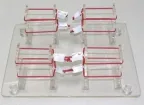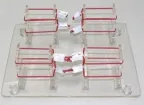In the pursuit of excellence in medical technology, the improvement of every detail is crucial. Today, we introduce to you a superficial knotting skills training model that leads industry changes. It will provide doctors with a new learning platform and help them achieve more outstanding achievements in the medical field.

With its unique design and excellent performance, this training model provides doctors with a realistic and efficient training environment. Through highly simulated human tissue materials and sophisticated mechanical design, it can simulate various complex surgical scenarios, allowing doctors to constantly challenge themselves and improve their skills in practice.
Compared with traditional training methods, this training model has more prominent advantages. It can not only simulate various surgical scenarios, but also intelligently adjust the training difficulty and feedback methods according to the doctors' operating habits and level. This allows doctors to train in a situation that is closer to the real surgical environment, thereby mastering the correct knotting skills more quickly and improving the proficiency and accuracy of surgical operations.
In addition, this training model is extremely easy to use and portable. It adopts a modular design to facilitate doctors to train anytime and anywhere. Whether it is practical operations in the hospital or self-improvement at home, this model can provide doctors with convenient and efficient training support.
Promoting this training model is not only a strong support for improving the skills of doctors, but also a positive contribution to the development of the medical industry. It will help doctors better master the basic skill of superficial knot tying, improve the quality of surgery, reduce the occurrence of complications, and protect the health of patients.
At the same time, we are also well aware of the importance of promotion work. We will hold training courses and carry out publicity activities to let more doctors understand and use this training model. We will also actively collect user feedback and continuously optimize the function and performance of the model to meet the growing learning needs of doctors.
Looking to the future, we believe this superficial knotting skills training model will play an increasingly important role in the medical field. It will help doctors continuously improve their skills and bring good news to more patients. Let us work together to create a new chapter in improving medical skills!

